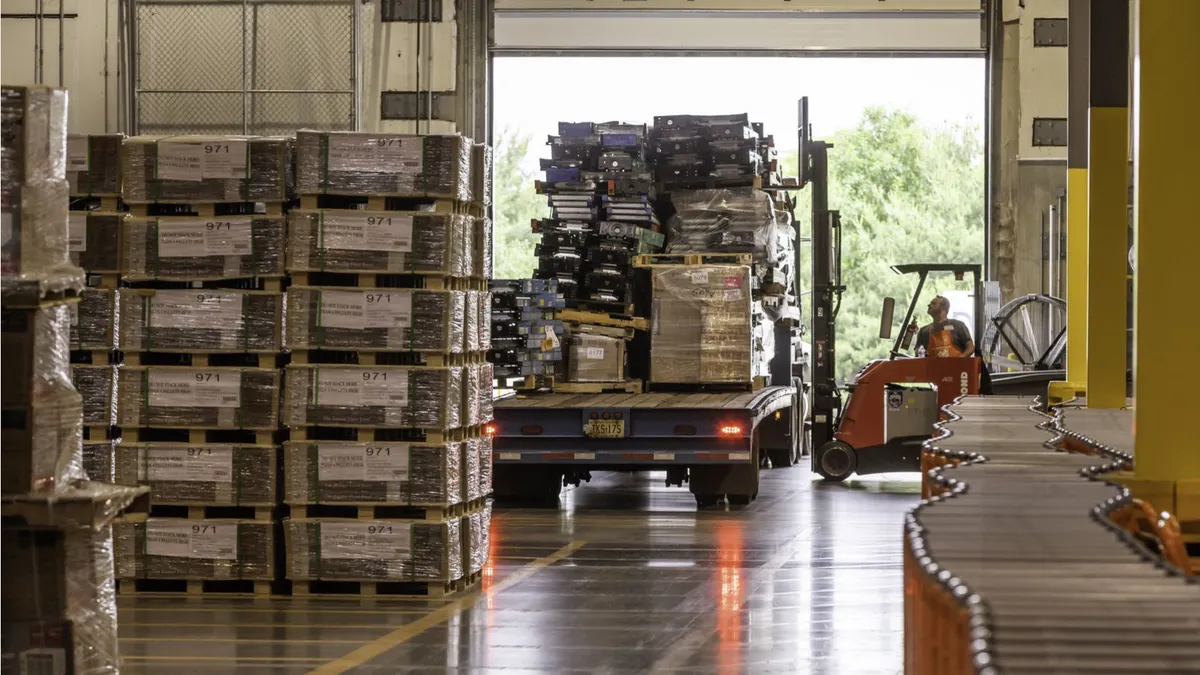Before the coronavirus pandemic, many retailers saw warehouse management systems (WMS) as an important investment area. The State of Retailing Online 2020 report from the National Retail Federation and Forrester found 73% of retailers are investing in WMS. And 63% of respondents said WMS technology expense was simply the cost of doing business, according to the survey.
Procuring and deploying WMS was also a face-to-face process before COVID-19. But the pandemic has driven many firms to work remotely and warehouses to enact social distancing measures, complicating the process for standing up a new WMS, experts told Supply Chain Dive.

One forecast from Arc Advisory Group predicts the WMS market will decline slightly in 2020 before rebounding, but the "mission-critical" role of the technology will keep the market somewhat stable through the current financial downturn.
"I do think 2020 is probably going to be a tough year for some of the vendors for a couple reasons," Dwight Klappich, a VP analyst focused on supply chain at Gartner, told Supply Chain Dive in an interview. The current work environment has made it harder to deliver software, which could hurt vendors that rely heavily on consulting revenue. It can also be difficult to sell these products over the phone, he said.
"During the pandemic, it was hard for [clients] to implement those kinds of systems because usually, you need people on site to help with it," George Lawrie, a VP and principal analyst working in serving application development and delivery professionals at Forrester, told Supply Chain Dive in an interview.
Many warehouse operators have placed greater focus on new priorities like figuring out how to get employees to social distance while at work, Lawrie said.
"But it's not disastrous, which actually I think bodes well," Klappich said. "I think the need and the demand continue to be there."
An in-person process moves to FaceTime
For the last 30 years, vendors have largely sold complex software systems like WMS through in-person meetings, Klappich said.
The sales process can include a multi-day demonstration in a conference that includes multiple people from each company so the vendor can learn about the buyer's company and the buyer can learn about the WMS.
"You don't get that same experience on the video," Klappich said, adding that there is a lot that can be done remotely and people are beginning to make the move.
"I've droned on into a webcam for three hours at a time. We've had to find ways to creatively have fun and break that up."

Jeremy Hudson
Director of Consulting Services, Open Sky Group
Implementing a WMS in the past required the buyer and vendor to come together with a whiteboard to talk about process mapping and building the software model. During these meetings, the company goes through its pick, pack and ship processes, replenishment plans, and other details that will need to be included in the WMS.
"That piece we've struggled with [is] how do we do that completely remote?" Klappich said, adding that the process can require eight to 10 hours of meetings every day for up to 15 weeks.
Jeremy Hudson, the director of consulting services for Open Sky Group, a WMS provider, acknowledged the struggle of this new reality, but said his team was finding ways to make long video calls more bearable. He has worked on three WMS projects going live since March.
"I've droned on into a webcam for three hours at a time," Hudson said. "We've had to find ways to creatively have fun and break that up." This could include short five to 10 minute segments to allow for a team talent show, or anything to break up the monotony of an all-day video call, he said.
Of the three projects Hudson has worked on since March, two were done completely remotely. The difficulty of the project depended on the company, he said.
One company working with Open Sky was manufacturing cold and flu medicine, but its suppliers weren't considered essential, which allowed for a slower, easier implementation.
"It gave us a kind of slower ramp-up period in terms of going live," he said. "Where we expected potentially 15 to 20 trucks the first week, it ended up being two trucks the first week."
But the other project was for a business that saw the commodity price skyrocket "basically the moment we turned on their new WMS," he said. "It was incredibly complicated to try to support that both on site and remotely."
Training and support in a remote world has involved a lot of screen sharing, virtual whiteboarding, process mapping technology and video chats. When Open Sky was on site, it was able to monitor the process and help out right away if something pops up. When issues started arriving remotely, investigators had to retrace the steps of the process, so Open Sky asked customers to call as soon as the WMS started to produce unusual results.
"It's been as simple as they'll FaceTime my support resource and literally be showing them what the screen looks like in front of them," Hudson said. "As simplistic as that sounds, it's 'here's the RF gun in my hand, right? The mobile unit that I'm scanning the product with, why does that say this?'"
From there, Open Sky can help to figure out the problem. Was the master data incorrect? Were the order dimensions wrong?
Hudson has even taken an entire tour of a California warehouse through FaceTime. "It was effective for what we needed to accomplish," he said, adding that these meetings are helpful for understanding a company's complexity level.
How a WMS helps in the pandemic and beyond
WMS implementation and usage is different during the pandemic not only for companies using WMS for the first time, but also for warehouses with the software already in place but seeking more creative ways to use the systems.
"Warehouses don't stop operating during a pandemic," Klappich said.
Some managers see WMS as a tool that can help keep workers safe from infection.
Hudson said one customer approached Open Sky about creating a prompt on the WMS that asked employees if they were wearing their personal protective equipment (PPE) before work. Another client asked about limiting the number of users within a zone to enforce social distancing.
Others are interested in bringing in more robotics to automate tasks and keep humans safe. WMS can help a user understand patterns in the most frequently requested SKUs and locations where pickers frequently travel, which is data that's nice to have before building out a robotics application, Lawrie said.
"Warehouses don't stop operating during a pandemic."

Dwight Klappich
VP analyst, Gartner
"I do believe there'll be a lot more investment in this afterwards," Lawrie said of WMS investment following the pandemic.
Gartner has seen a lot of WMS proposal reviews in the second quarter, the busy time for which is usually during the fourth and first quarters, Klappich said.
"They said, 'Hey, this is a good time. Let's push forward to this evaluation and be ready to make a move when things turn around,"' he said. "Saying that bodes well that there's a lot of customers doing that."
This story was first published in our weekly newsletter, Supply Chain Dive: Operations. Sign up here.















